中国饮食文化翻译
- 格式:doc
- 大小:56.00 KB
- 文档页数:2
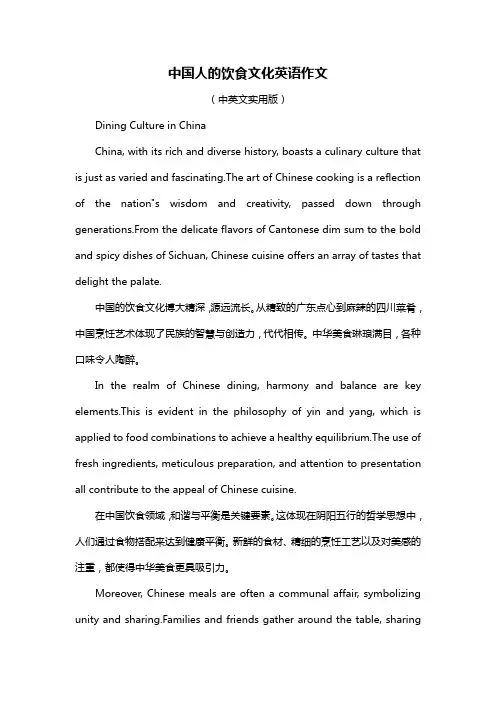
中国人的饮食文化英语作文(中英文实用版)Dining Culture in ChinaChina, with its rich and diverse history, boasts a culinary culture that is just as varied and fascinating.The art of Chinese cooking is a reflection of the nation"s wisdom and creativity, passed down through generations.From the delicate flavors of Cantonese dim sum to the bold and spicy dishes of Sichuan, Chinese cuisine offers an array of tastes that delight the palate.中国的饮食文化博大精深,源远流长。
从精致的广东点心到麻辣的四川菜肴,中国烹饪艺术体现了民族的智慧与创造力,代代相传。
中华美食琳琅满目,各种口味令人陶醉。
In the realm of Chinese dining, harmony and balance are key elements.This is evident in the philosophy of yin and yang, which is applied to food combinations to achieve a healthy equilibrium.The use of fresh ingredients, meticulous preparation, and attention to presentation all contribute to the appeal of Chinese cuisine.在中国饮食领域,和谐与平衡是关键要素。
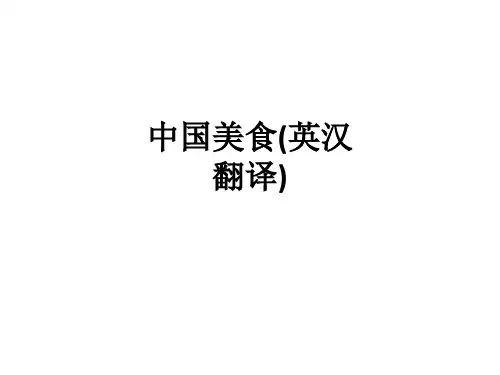
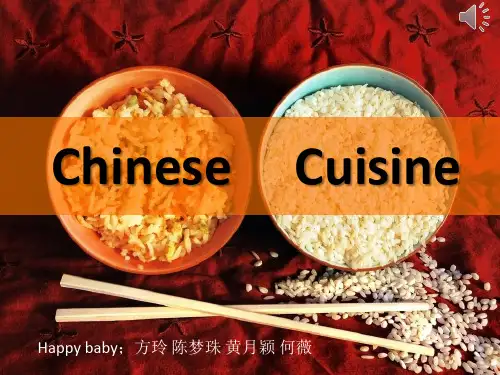
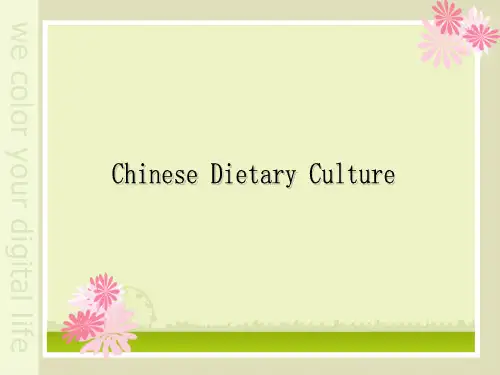

历史文化类(二)1. 中国传统节日中国传统节日traditional Chinese festival ★★★过节celebrate a festival ★★☆放假have a holiday / vacation ★★☆文化积淀cultural accumulation ★★☆文化凝聚cultural cohesion ★★☆记录社会文化生活record the moments of social and cultural life ★★☆节气solar term ★★☆季节变迁seasonal change / transition ★★☆公历历法solar calendar ★★☆地球绕太阳公转的周期period of the Earth’s revolution around the Sun ★☆☆农历历法lunar calendar ★★☆月球绕地球公转的周期period of the Moon’s revolution around the Earth ★☆☆农业生产agricultural product ion ★★☆科学指导scientific guidance / instruction ★★☆日常社会生活everyday social life ★★☆祭祀活动ritual / sacrificial activity ★★☆庆祝活动celebratory activity; celebration ★★☆春节the Spring Festival ★★★元宵节the (Spring) Lantern Festival ★★★清明节the Qingming Festival; Tomb-Sweeping Day ★★★端午节the Dragon Boat Festival ★★★七夕节the Qixi Festival; the Double Seventh Festival; the Chinese Valentine’s Day ★★★ 中秋节the Mid-Autumn Festival ★★★重阳节the Double Ninth Festival ★★★农历几月几日fall on the+序数词+day of the+序数词+luna r month ★★★追溯到date back to; be traced back to ★★★有……年历史have a history of XX years ★★★传说……According to legend, … / Legend has it that… ★★★为了庆祝in celebration of ★★★为了纪念in honour / memory of ★★★风俗习惯social customs and habits ★★★中国农历新年Chinese lunar new year ★★★腊月the twelfth month of the lunar year ★★☆正月the first month of the lunar year ★★☆迎接新年的到来welcome the arrival of the new year ★★☆除尘clean the house ★★☆沐浴更衣take a bath and put on clean clothes ★★☆理发have a haircut ★★☆祛除晦气和霉运get rid of one’s bad luck / ill-fortune ★★☆置办年货purchase necessities for the new year ★★☆招待亲朋好友entertain relatives and friends ★★☆烘托节日的气氛add an air of festivity ★★☆大年三十Chinese New Year’s Eve ★★★贴春联paste Spring Festival couplets ★★☆贴“福”字paste the Chinese character “Fu” ★★☆贴窗花paste window paper-cuts ★★☆吃团圆年夜饭have New Year Eve reunion dinner ★★☆看春晚watch the Spring Festival Gala ★★☆燃放烟花爆竹set off fireworks and firecrackers ★★☆辞旧迎新ring out the Old Year; ring in the New Ye ar ★★☆正月初一the first day of the lunar new year ★★★穿上新衣新鞋put on new clothes and shoes ★★☆祈求新的开始pray for a new beginning in life ★★☆新年贺礼New Year gifts / presents ★★☆走亲访友visit / call on relatives and friends ★★☆给……拜年give sb. New Year greetings ★★☆红包red packet / envelope ★★★压岁钱money given to children as a New Year gift ★★☆好运good luck / fortune ★★★长寿longevity ★★★ 幸福happiness ★★★喜庆场合festive occasion ★★☆灯会lantern show / exhibition ★★☆赏花灯appreciate colourful lanterns ★★☆猜灯谜guess lantern riddles ★★☆观看舞龙舞狮表演watch the dragon-lion dance performances ★★☆悠久历史文化time-honoured history and culture ★★★精神文化遗产spiritual and cultural heritage ★★☆全球化飞速发展的今天in this rapidly globalizing world ★★☆西方文化思想Western cultures and thoughts ★★☆过洋节celebrate the Western festivals ★★☆传统节日的传承inheritance of traditional festivals ★★☆弘扬中国传统文化carry forward traditional Chinese culture ★★☆传承中华传统美德inherit the traditional virtues of the Chinese nation ★★☆ 增强民族凝聚力e nhance / strengthen national cohesion ★★☆2. 中国饮食文化饮食文化food culture ★★★春卷Chinese spring roll ★☆☆汤圆tangyuan (sweet rice dumpling) ★☆☆青团qingtuan (sweet green rice ball) ★☆☆粽子zongzi (Chinese rice-pudding) ★★★月饼mooncake ★★★重阳糕Double-Ninth cake ★☆☆饮食习惯eating / dietary habits ★★★主食staple food ★★☆大米/水稻rice ★★★馒头steamed bun ★★★面条noodles ★★★农作物crop ★★★小麦wheat ★★★副食non-staple / subsidiary food ★★☆鸡肉chicken ★★★鸭肉duck ★★★鱼肉fish ★★★水果fruit ★★★蔬菜vegetable ★★★维持均衡的膳食maintain a well-balanced diet ★★☆摄取所需的营养obtain adequate nourishment ★★☆确保健康secure physical health ★★☆避免疾病avoid / prevent diseases ★★☆传统待客之道traditional hospitality ★★★菜品种类丰富a rich / wide variety of dishes ★★☆宴席feast / banquet ★★★凉菜cold dish ★★★开胃菜appetizer ★★☆味蕾taste bud ★★☆主菜main course ★★★热菜hot dish ★★★肉类meat ★★★家禽poultry ★★★海鲜seafood ★★★时蔬seasonal vegetable ★★★甜点dessert ★★★清淡食物light food ★★☆解油腻get rid of the greasy feeling after eating fatty / oily food ★☆☆ 助消化help / facilitate digestion ★★☆食材ingredient ★★☆烹饪风格cooking style ★★★菜系cuisine ★★★家乡菜hometown dish ★★☆八大菜系China’s 8 major regional cuisines ★★☆川菜Sichuan cuisine ★★☆鲁菜Sh andong cuisine ★★☆粤菜Cantonese cuisine ★★☆苏菜Jiangsu cuisine ★★☆浙菜Zhejiang cuisine ★★☆闽菜Fujian cuisine ★★☆湘菜Hunan cuisine ★★☆徽菜Anhui cuisine ★★☆特色菜speciality ★★☆色、香、味俱全a perfect combination of appearance, aroma and flavour ★★☆ 酸sour ★★☆甜sweet ★★☆苦bitter ★★☆辣spicy ★★☆咸salty ★★☆大厨chef ★★☆佐料seasoning ★★☆柴firewood ★★☆米rice ★★☆油cooking oil ★★☆盐salt ★★☆酱sauce ★★☆醋vinegar ★★☆茶tea ★★☆神农氏Shennong ★☆☆尝百草taste hundreds of herbs ★☆☆解毒clear away toxic materials; get rid of the poisoning effect ★☆☆茶馆teahouse ★★☆茶树tea tree ★★☆种植在山上plant on hills ★★☆茶叶的质量quality of tea leaves ★★☆得名于get name because… ★★☆浓郁strong ★★☆持久long-lasting ★★☆清淡faint ★★☆香甜sweet ★★☆唇齿留香f eel the flavour in mouth / on lips for a long time ★★☆修身养性cultivate moral characters ★★☆陶冶情操cultivate sentiments ★★☆去除杂念remove distracting thoughts ★★☆【补充词汇】1. 二十四节气立春spring begins ★☆☆雨水more rain than snow ★☆☆惊蛰hibernating insects awake n ★☆☆春分spring center ★☆☆清明clear and bright ★☆☆谷雨wheat rain ★☆☆立夏summer begins ★☆☆小满creatures plentish ★☆☆芒种seeding millet ★☆☆夏至summer maximum (solstice) ★☆☆小暑a bit sweltering ★☆☆大暑most sweltering ★☆☆立秋autumn begins ★☆☆处暑heat withdraws ★☆☆白露dews ★☆☆秋分autumn center ★☆☆寒露cold dews ★☆☆霜降frost ★☆☆立冬winter begins ★☆☆小雪snows a bit ★☆☆大雪snows a lot ★☆☆冬至winter maximum ★☆☆小寒a bit frigid ★☆☆大寒most frigid ★☆☆2. 中国传统节日黄金周golden week ★★★国家法定假日official national holiday ★★★烧香burning incense ★☆☆纸钱joss paper ★☆☆祭祖宗offer sacrifices to one’s ancestors ★★☆ 孔明灯Kongming lantern ★☆☆子孙后代offspring ★★☆纪念碑memorial tablet ★☆☆悼文memorial essay ★☆☆网上祭扫online tomb-sweeping ★★☆扫墓sweep tombs ★★☆扫墓者tomb sweeper ★★☆踏青spring outing ★★☆绿柳green willow ★★☆伟大的爱国诗人great patriotic poet ★★☆楚国the state of Chu ★★☆爱国主义patriotism ★★☆奉献精神dedication ★★☆不朽的著作immortal masterpiece ★★☆赛龙舟dragon-boat racing ★★★带香囊wear perfu med medicine bags ★☆☆鹊桥the bridge of magpies ★☆☆王母娘娘Goddess of Heaven ★☆☆银河the Milky Way ★★☆庆祝丰收celebrate harvest ★★☆拜月worship the moon ★★☆赏月enjoy the moon’s beauty; appreciate the full moon ★★☆合家团聚family reunion ★★★嫦娥奔月Chang’e Flying to the Moon ★☆☆登高/爬山mountain climbing ★★☆去除厄运dispel bad luck ★★☆去除恶灵dispel evil spirits ★★☆带来好运bring good fortune ★★★尊敬老人show respect for elders ★★★3. 中国饮食文化谷物grain ★★★面粉flour ★★☆面包bread ★★★糕点pastry ★★☆小吃snack ★★★菜谱recipe ★★☆菜单menu ★★★全鱼the whole fish ★★★汤soup ★★★美食家gourmet ★★☆餐具tableware ★★☆菜肴的装盘和摆放the layout and design of the dishes ★★☆ 佐料的搭配the blending of seasoning ★★☆调味的艺术the art of proper seasoning ★★☆烹饪艺术culinary art ★★☆煮boil ★★☆清蒸steam ★★☆ 清炒plain-fry ★☆☆油炸deep-fry ★☆☆ 烘培roast ★★☆刀工slicing technique ★☆☆烹饪餐具cooking utensil ★★☆饮料beverage ★★☆茶具tea set ★★☆茶壶teapot ★★☆茶杯teacup ★★☆茶托saucer ★★☆紫砂purple sand ★☆☆陶器pottery ★★☆瓷器porcelain ★★☆茶道tea ce remony ★☆☆食疗Chinese food therapy ★★☆食补保健maintain good health through the intake of nourishing food ★★☆4. 其它文化类词汇文化多样性cultural diversity ★★★多元文化社会multicultural society ★★★跨文化交流cross-cultural communication ★★★文化交流与合作cultural exchange and cooperation ★★★文化繁荣cultural prosperity ★★★东方文化Eastern / Oriental culture ★★★民俗文化folk culture ★★☆传统意识形态traditional ideology ★★☆丰富文化生活enrich cultural life ★★☆中国结Chinese knot ★★☆手工艺handicrafts ★★☆手工艺人handicraftsman ★★☆祈求好运pray for good luck ★★☆辟邪ward off evil spirits ★★☆中医traditional Chinese medicine ★★★针灸acupuncture ★☆☆穴位acupuncture point ★☆☆推拿medical massage ★☆☆拔火罐疗法cupping therapy ★☆☆理疗physical therapy ★☆☆医疗保健health care ★★★心heart ★★☆肝liver ★★☆脾spleen ★★☆胃stomach ★★☆肺lung ★★☆肾kidney ★★☆中草药Chinese herbal medicine ★★☆副作用side effect ★★☆切脉feel the pulse ★☆☆偏方folk prescription ★☆☆秘方secret prescription ★☆☆传统中国画traditional Chinese painting ★★★饮茶下棋drink tea and play chess ★★☆耕耘收割plough and harvest ★★☆织布缝衣weave and sew ★★☆砍柴采药cut firewood and gather herbs ★★☆吟诗作画compose poems and draw pictures ★★☆中国书画Chinese painting and calligraphy ★★★山水画Chinese landscape painting ★☆☆水墨画Chines e ink and wash painting ★☆☆汉字Chinese character ★★★文房四宝the four treasures of the Chinese study ★★☆ 笔墨纸砚brush, ink, paper and ink stone ★★☆中国传统体育运动traditional Chinese sports ★★★功夫/武术kung fu; Chinese martial arts ★★★自卫self-defence ★★☆国宝nation al treasure ★★☆太极拳Tai Chi; shadow boxing ★★★中国传统服饰traditional Chinese costume ★★★民族服饰national costume ★★★宽松长袍loose robe ★★☆女性美women’s beauty ★★☆时装秀fashion show ★★☆社交聚会social gathering ★★☆中国民乐Chinese folk music ★★☆乐器musical instrument ★★☆中国传统戏曲traditional Chinese opera ★★☆中国生肖Chinese zodiac ★★☆。
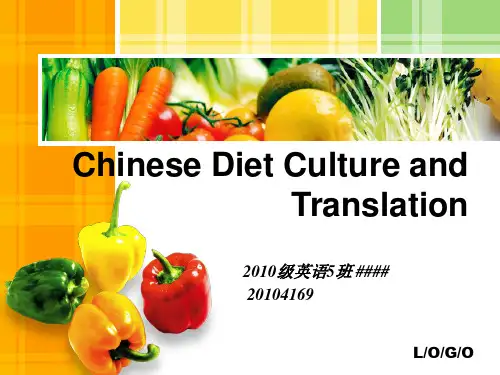
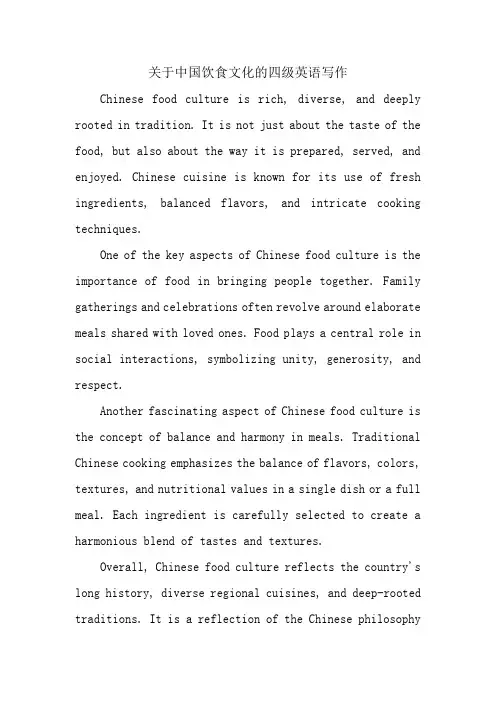
关于中国饮食文化的四级英语写作Chinese food culture is rich, diverse, and deeply rooted in tradition. It is not just about the taste of the food, but also about the way it is prepared, served, and enjoyed. Chinese cuisine is known for its use of fresh ingredients, balanced flavors, and intricate cooking techniques.One of the key aspects of Chinese food culture is the importance of food in bringing people together. Family gatherings and celebrations often revolve around elaborate meals shared with loved ones. Food plays a central role in social interactions, symbolizing unity, generosity, and respect.Another fascinating aspect of Chinese food culture is the concept of balance and harmony in meals. Traditional Chinese cooking emphasizes the balance of flavors, colors, textures, and nutritional values in a single dish or a full meal. Each ingredient is carefully selected to create a harmonious blend of tastes and textures.Overall, Chinese food culture reflects the country's long history, diverse regional cuisines, and deep-rooted traditions. It is a reflection of the Chinese philosophyof harmony, balance, and the importance of sharing meals with others.中文翻译:中国饮食文化丰富多彩,深深扎根于传统之中。
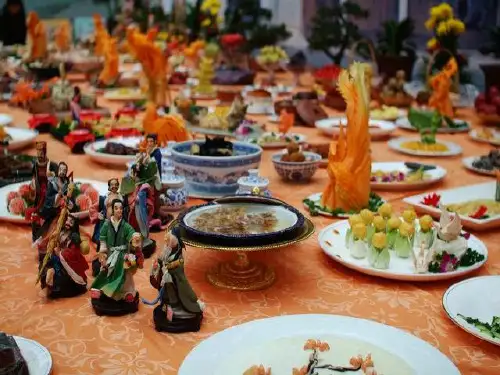
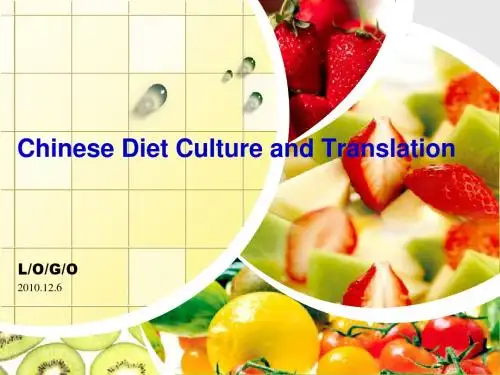
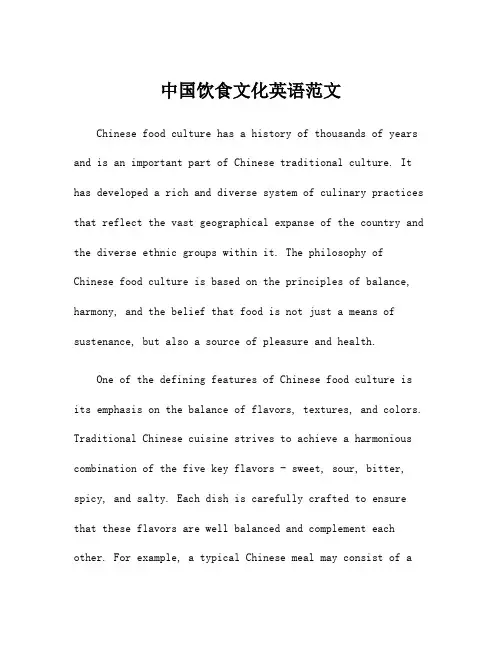
中国饮食文化英语范文Chinese food culture has a history of thousands of years and is an important part of Chinese traditional culture. It has developed a rich and diverse system of culinary practices that reflect the vast geographical expanse of the country and the diverse ethnic groups within it. The philosophy of Chinese food culture is based on the principles of balance, harmony, and the belief that food is not just a means of sustenance, but also a source of pleasure and health.One of the defining features of Chinese food culture is its emphasis on the balance of flavors, textures, and colors. Traditional Chinese cuisine strives to achieve a harmonious combination of the five key flavors - sweet, sour, bitter, spicy, and salty. Each dish is carefully crafted to ensure that these flavors are well balanced and complement each other. For example, a typical Chinese meal may consist of avariety of dishes, each with a different flavor profile, such as a sweet and sour dish, a spicy stir-fry, and a savory soup.In addition to flavor, the texture of food is also an important consideration in Chinese cuisine. Chinese chefsoften pay close attention to the texture of ingredients and aim to create dishes with a variety of textures, such as crispy, tender, and chewy. This attention to texture adds complexity and interest to the dining experience.Another distinctive feature of Chinese food culture isthe importance placed on the visual presentation of dishes. Chinese chefs often pay as much attention to the visualappeal of a dish as they do to its taste and texture. Traditional Chinese dishes are often colorful and artfully arranged to create a visually stunning presentation. The useof vibrant and contrasting colors, as well as intricate garnishes, adds to the overall aesthetic and sensory experience of the meal.Beyond the principles of flavor, texture, and presentation, Chinese food culture also places a strong emphasis on the health-giving properties of food. Traditional Chinese medicine has long held that food is a form of medicine, and the practice of using food to maintain and improve health is deeply ingrained in Chinese culinary traditions. Many traditional Chinese ingredients and cooking methods are believed to have health-promoting properties, and Chinese cuisine often includes a wide variety of nutrient-rich foods, such as fresh vegetables, seafood, and herbal ingredients.Furthermore, the social aspect of food is also an important component of Chinese food culture. In Chinese society, meals are often viewed as a time for families and friends to come together and bond. Sharing meals is considered a way to strengthen social ties and build relationships. As a result, there are many customs and etiquettes associated with Chinese dining, such as thepractice of serving and sharing dishes family-style, and the use of communal dining utensils.In conclusion, Chinese food culture is a complex and multifaceted system that encompasses a rich and diverse array of culinary practices. It is defined by a strong emphasis on the principles of balance, harmony, and health, as well as the importance of flavor, texture, and visual presentation. At its core, Chinese food culture is a reflection of the deep-seated beliefs, customs, and traditions that have shaped Chinese society for thousands of years.。

中国的饮食文化英语作文Chinese Food Culture。
China, a country with a long history and rich culture, is known for its diverse and unique cuisine. Chinese food culture is not only about the taste of the food but also emphasizes the balance of flavors, colors, and textures. It is a reflection of the Chinese philosophy of Yin and Yang, which emphasizes the harmony and balance of all things.One of the most distinctive features of Chinese cuisine is its regional diversity. China is a vast country with different climates, landscapes, and ethnic groups, which have all contributed to the development of various regional cuisines. The most well-known regional cuisines include Sichuan, Cantonese, Shandong, and Hunan cuisine. Each region has its own unique ingredients, cooking techniques, and flavors, making Chinese cuisine a treasure trove of flavors and tastes.Chinese food is not only known for its delicious taste but also its health benefits. Traditional Chinese medicine believes that food can be used as medicine to maintain a healthy body and prevent diseases. Many ingredients used in Chinese cooking, such as ginger, garlic, and various herbs, are believed to have medicinal properties. For example, ginger is often used to relieve digestive problems, while garlic is known for its antibacterial properties. In addition, Chinese cooking methods, such as stir-frying and steaming, help retain the nutrients in the food, making it healthier and more nutritious.Another important aspect of Chinese food culture is its emphasis on the art of dining. In Chinese culture, eating is not just about satisfying hunger, but also about socializing and building relationships. Chinese people often gather with family and friends to enjoy a meal together, which is seen as a way to strengthen bonds and show hospitality. The Chinese also pay great attention to the presentation of food. A well-presented dish not only looks appetizing but also reflects the chef's skill and creativity.Chinese food culture has also influenced the dining habits of people around the world. Chinese restaurants can be found in almost every corner of the globe, serving dishes like sweet and sour pork, Kung Pao chicken, andfried rice. Chinese food has become popular not only forits taste but also for its affordability and convenience. In recent years, Chinese cuisine has also been recognized by UNESCO as an intangible cultural heritage, further highlighting its significance and influence.In conclusion, Chinese food culture is a reflection of the country's rich history, diverse regional cuisines, and emphasis on health and harmony. It is not just about the taste of the food but also about the art of dining and the social aspect of eating. Chinese cuisine has become popular worldwide, and its influence can be seen in the dining habits of people from different cultures. Chinese food culture is truly a treasure that should be celebrated and appreciated.。
中国饮食文化英语作文Chinese food culture is incredibly diverse and rich in history. From the spicy flavors of Sichuan cuisine to the delicate dim sum of Cantonese cooking, there is somethingfor everyone to enjoy. The use of fresh ingredients and a balance of flavors are key elements in Chinese cooking, making it a truly unique and delicious experience.One of the most important aspects of Chinese foodculture is the concept of balance. This can be seen in the way that dishes often incorporate a combination of flavors such as sweet and sour, or salty and spicy. This balance is not only important for the taste of the food, but also for the overall health benefits that Chinese cuisine is known for.In addition to balance, Chinese food culture alsoplaces a strong emphasis on the importance of communal dining. Many dishes are designed to be shared among a group, encouraging a sense of togetherness and community. Thiscommunal aspect of Chinese dining is a reflection of the value that Chinese culture places on family and relationships.Another unique aspect of Chinese food culture is the use of traditional cooking techniques such as stir-frying, steaming, and braising. These methods have been passed down through generations and are still widely used today. They not only contribute to the distinct flavors of Chinese cuisine, but also reflect the deep-rooted traditions and history of the culture.Finally, Chinese food culture is also closely tied to the concept of food as medicine. Many traditional Chinese ingredients are believed to have healing properties and are used in dishes to promote health and well-being. This holistic approach to food and health is an integral part of Chinese culture and is something that sets it apart from other culinary traditions.In conclusion, Chinese food culture is a vibrant and diverse part of Chinese society. From the emphasis onbalance and communal dining to the use of traditional cooking techniques and the belief in food as medicine, there is much to be appreciated and enjoyed in Chinese cuisine. It is truly a reflection of the rich history and values of Chinese culture.。
Chinese Food Culture1.Characteristics of cuisines in southern part of ChinaChinese cuisine has a number of different genres, but the most influential and typical known by the public are the 'Eight Cuisines'. These are as follows: Shandong Cuisine, Guangdong Cuisine, Sichuan Cuisine, Hunan Cuisine, Jiangsu Cuisine, Zhejiang Cuisine, Fujian Cuisine and Anhui Cuisine.We have roughly separated Chinese cuisine into two genres. They are Cuisines of the north part and the southern part. Cuisines of the southern part of China are really featured. They have various differences with northern cuisine.Firstly, abundant rain drops and sunlight in South China provide favorable conditions for the growth of millet and rice. Compared with people in North China who have to spend much time in cold weather, people in South China are less preferable to meat diet, which contains lots of fat and protein. Southern Chinese prefer plant diet quite a lot. Many people are accustomed to drink soup both before and after the meal. Guangdong Soup(老火靓汤)Secondly, South China is one of the most developed areas in China. It welcomes people from the entire world. As a result, Southern Cuisine, especially Guangdong Cuisine, emphasizes a flavor which is clear but not light, refreshing but not common, tender but not crude.Thirdly,People in South China tend to be more careful and sensitive than northern people. As a result, their dishes as well as appearance are really cute and attractive. Just like dim sum(点心), which means “touch the heart”, is one of the most famous Cantonese meal. It consists of a variety of delicacies and is usually served for breakfast or dinner.Spicy-hot Fish麻辣鱼Mapo Tofu (Stir-Fried Tofu in Hot Sauce)麻婆豆腐Pork Rips排骨)Penaeus orientalis对虾2.Characteristics of cuisines in northern part of ChinaCuisines of the north part of China have several characteristics.people in the north tend to eat cooked wheaten food. Or in other words, people eat more food made of flour. This is because the climate here is temperate continental climate, which means there are less rain drops and sunlight. And this climate provides favorable conditions for the growth of wheat.First,When it comes to cooked wheaten food, there is a place many people are familiar with. That is Shanxi(山西). As the saying goes, “east or west, Shanxi cooked wheaten food is best”. Shanxi is famous for its diverse and delicious cooked wheaten food. With a history of 2000years, Shanxi cooked wheaten food is gaining more and more popularity at home and even abroad.Cooked wheaten food in Shanxi,there are round 280 kinds of cooked wheaten food, among which the sliced noodles is the most renowned one.Apart from the sliced noodles刀削面, boiled food also includes hand-pulled noodles拉面, He lao饸饹)Tijian,剔尖Maoerduo猫耳朵, Jiupian(揪片) ,which are all delicious and tasty.As for the cooked food, it includes fried cake(炸糕)、Yi wo su(一窝酥)、fried dough twist (麻花),Shuai bing(甩饼) and so on.Other steamed wheaten food includes steamed bun、You mian kao lao(莜面栲栳)、Gao liang mian yu(高粱面鱼).Second, food in the north is often more salty and greasy than that in the south.Because people like to add more ingredient to dishes even the soup.Shandong cuisine and Beijing cuisines are two famous cuisines of the eight cuisines in china. And they are also representatives of the northern cuisines. Beijing cuisine is famous for its Beijing roast duck and instant-boiled mutton. Shandong food is always pure, fresh, tender, salty and crisp.Chinese people pay much attention to eating, not just to fulfill our basic needs, but deep within, it contains the measures Chinese people take to understand things. For example, when a child was born, relatives and friends would eat eggs painted in red color to celebrate. Eggs symbolize new lives, eating red eggs embodies the high expectations of the Chinese to carry on the family line. We have feasts in the weddings; we celebrate our birthdays with gatherings and delicious food; we gather with our friends or families to eat, which is a good way to enhance our intimacy.。
一、官方译名的翻译原则
中餐菜单的翻译涉及内容颇多。
不仅要考虑菜品的原料、烹饪方法,还要照顾到人名、地名和一些特有品名的叫法。
北京市外办
公布的官方菜单译名中,对中文菜单的英译都采用了什么样的翻译原则呢?
以主料为主,配料或配汁为辅的翻译原则
1. 菜肴的主料和配料主料(名称/形状)+ with + 配料如:松仁香菇Chinese Mushrooms with Pine Nuts
2. 菜肴的主料和配汁主料+ with / in + 汤汁(Sauce) 如:冰梅凉瓜Bitter Melon in Plum Sauce
以烹制方法为主,原料为辅的翻译原则
1. 菜肴的做法和主料做法(动词过去分词)+ 主料(名称/形状) 如:拌双耳Tossed Black and White Fungus
2. 菜肴的做法、主料和配料做法(动词过去分词) + 主料(名称/形状)+ 配料如:豌豆辣牛肉Sautéed Spicy Beef and Green Peas
3. 菜肴的做法、主料和汤汁做法(动词过去分词) + 主料(名称/形状)+ with / in + 汤汁如:川北凉粉Tossed Clear Noodles with Chili Sauce
以形状、口感为主,原料为辅的翻译原则
1. 菜肴形状或口感以及主配料
形状/口感+ 主料如:玉兔馒头Rabbit-Shaped Mantou
2. 菜肴的做法、形状或口感、做法以及主配料
做法(动词过去分词)+ 形状/口感+ 主料+ 配料如:小炒黑山羊Sautéed Sliced Lamb with Pepper and Parsley
以人名、地名为主,原料为辅的翻译原则
1. 菜肴的创始人(发源地)和主料
人名(地名)+ 主料如:麻婆豆腐Mapo Tofu (Sautéed Tofu in Hot and Spicy Sauce) 2. 介绍菜肴的创始人(发源地)、主配料及做法
做法(动词过去式)+ 主辅料+ 人名/地名+ Style 如:四川辣子鸡Spicy Chicken, Sichuan Style
体现中国餐饮文化,使用汉语拼音命名或音译的翻译原则
1. 具有中国特色且被外国人接受的传统食品,本着推广汉语及中国餐饮文化的原则,使用汉语拼音。
如:饺子Jiaozi
2. 具有中国特色且已被国外主要英文字典收录的,使用汉语方言拼写或音译拼写的菜名,仍保留其原拼写方式。
如:豆腐Tofu
3. 中文菜肴名称无法体现其做法及主配料的,使用汉语拼音,并在后标注英文注释。
如:佛跳墙Fotiaoqiang ( Steamed Abalone with Shark’s Fin and Fish Maw in Broth )
可数名词单复数使用原则
菜单中的可数名词基本使用复数,但在整道菜中只有一件或太细碎无法数清的用单数。
如:蔬菜面Noodles with Vegetables
介词in和with在汤汁、配料中的用法
1. 如主料是浸在汤汁或配料中时,使用in连接。
如:豉汁牛仔骨Steamed Beef Ribs in Black Bean Sauce
2. 如汤汁或蘸料和主料是分开的,或是后浇在主菜上的,则用with连接。
如:泡椒鸭丝Shredded Duck with Pickled Peppers
酒类的译法原则
进口酒类的英文名称仍使用其原文,国产酒类以其注册的英文为准,如果酒类本身没有英文名称的,则使用其中文名称的汉语
典例:
夫妻肺片Sliced Beef and Ox Tongue in Chili Sauce
凉拌黄瓜Shredded Cucumber with Sauce
卤水豆腐Marinated Tofu
蜜汁叉烧BBQ Pork with Honey Sauce
豉汁蒸排骨Steamed Spare Ribs in Black Bean Sauce。